A Comet in Orion, and an Early Evening Crescent Moon meets Gas Giants, and Shows Morning Meteors from Leo!
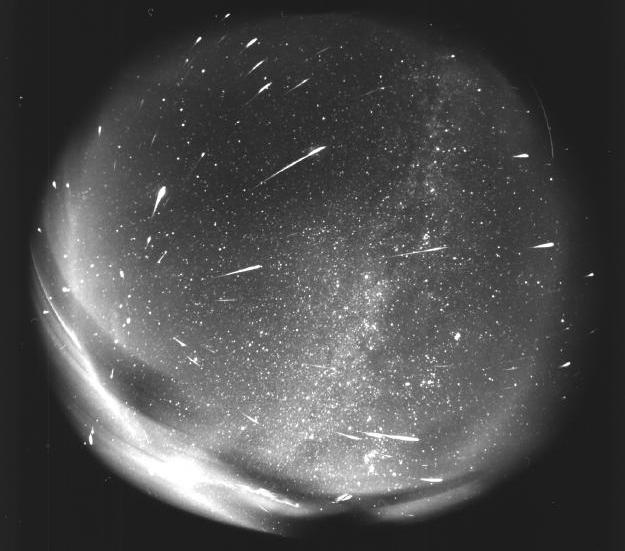
This all-sky image from November, 1998 by Juraj Toth of Modra Observatory, operated by Comenius University in Bratislava, shows about 100 Leonids meteors emanating from the region of sky near Leo. It was compiled during a 4 hour period. NASA APOD for November 4, 2001
Hello, mid-November Stargazers!
Here are your Astronomy Skylights for the week of November 15th, 2020 by Chris Vaughan. Feel free to pass this along to your friends and send me your comments, questions, and suggested topics. You can also follow me on Twitter as @astrogeoguy! Unless otherwise noted, all times are expressed in Eastern Time. To subscribe to these emails please click this MailChimp link.
I can bring my Digital Starlab portable inflatable planetarium to your school or other daytime or evening event, or teach a session online. Contact me through AstroGeo.ca, and we’ll tour the Universe, or the Earth’s interior, together!
The moon will return to the western post-sunset sky this week, leaving late evenings and pre-dawn skies darker worldwide – perfect for viewing Leonids meteors and Comet C/2020 M3 (Atlas) in Orion. Mars will continue its splendid all-night showing – with Uranus and Neptune sitting near it. Jupiter and Saturn will only be observable during early evening, but they’ll be visited by the moon on Thursday. Read on for your Skylights!
Happy Diwali!
Like many traditional observances around the world, the timing of the South Asian festival of Diwali, or the Festival of Lights, has an astronomical connection. Diwali celebrates the triumph of good over evil. It commences on the day of Amavasya – the new moon that falls on the 15th day of the Kartika month in the Hindu lunisolar calendar. The festival’s name arises from the Sanskrit expression deepa avali, or “rows of lighted clay lamps” – which were set outside when there was no moon to light the way at night. Diwali always occurs between mid-October and mid-November.
Leonids Meteor Shower
We’re now deep into meteor shower season! Over the next few months, we’ll experience a wave of several fine showers. The Leonids Meteor Shower, which is derived from bits of material dropped during each passage of periodic Comet 55P/Tempel-Tuttle, runs from November 5 to December 3, annually. The peak of the shower, when 10 to 20 meteors per hour are predicted – many with persistent trains – will occur at 23:00 Greenwich Mean Time on Tuesday, November 17 – when Earth will be traveling through the densest part of the comet’s debris train.
This shower is a worldwide event. The meteors can appear anywhere in a dark sky, but true Leonids will be travelling in a direction away from a location called the radiant that is positioned just above the stars that form the head of Leo (the Lion). (The radiant location gives each shower its name.) For observers in the Americas, the best viewing times for Leonids will be Tuesday morning and Wednesday morning before dawn, when the radiant will be high in the eastern sky. But don’t focus your attention on the radiant – meteors near it will have very short streaks because those meteors are traveling directly towards you.
You can watch for meteors during late evening, too – but many of them will be hidden from view below the Earth’s horizon. A young, crescent moon on the peak date will set soon after sunset, leaving the overnight and dawn sky nicely dark for meteors. Instead, find a safe, dark location with lots of open sky, get comfortable, and just look up.
To preserve your dark adaptation, try to keep your phone tucked away. If you must look at it, turn the screen brightness to minimum, and/or enabled the red screen mode available on some models. Don’t bother chasing meteors with binoculars or a telescope – those instruments have a field of view that is too narrow. But you can take long exposure photos of the sky and catch the meteors’ streaks. If the peak night is cloudy, don’t despair – the surrounding dates will still deliver some meteors. Happy viewing!
The Moon
After passing its new moon phase this morning (Sunday), our planetary partner will spend the coming week shining in the western evening sky as it waxes to first quarter phase on Saturday.
For moon-lovers all over the world, this week will be ideal for viewing Luna at her best. While we see the moon waxing in phase, the sun is rising over the moon’s eastern horizon. The pole-to-pole boundary that divides the moon’s dark and lit hemispheres is called the terminator. The terminator is curved when the moon is waxing and waning, and it becomes a straight line at first and last quarter. That’s how even ancient astronomers could ascertain that the moon had a spherical shape. You can run the same experiment using a ball and a light in a dark room.
The sunlight arriving onto the parts of the moon located just to the west of the terminator is nearly horizontal – so it casts long shadows from every crater rim, mountain peak, cliff face, and boulder. With no atmosphere to scatter light, the shadows are deep black. Any size of binoculars and telescope will show you spectacular views of the waxing moon.
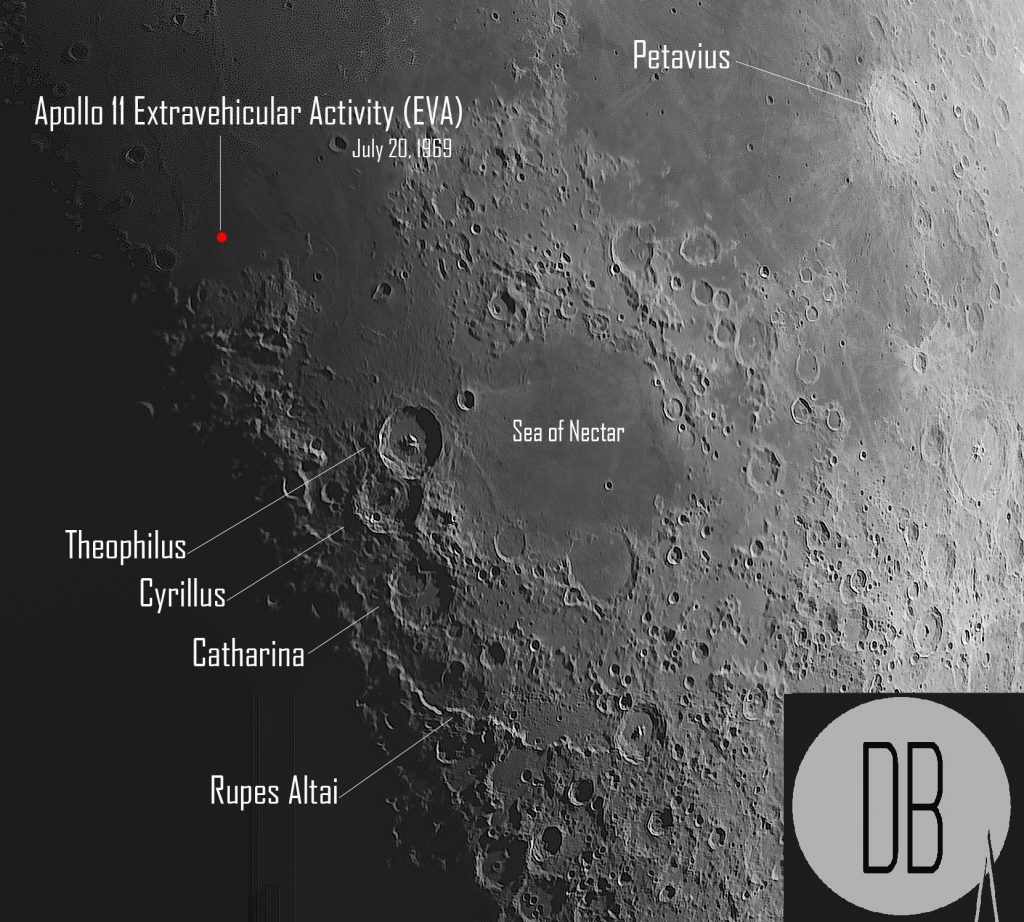
Since the moon is continually travelling around Earth, it is constantly varying its angle with the sun, as viewed from Earth. The terminator migrates east to west (or right to left seen from the Northern Hemisphere on Earth) – and the illumination of the terrain alongside it changes hour-by-hour and night-after-night. If you are lucky enough to experience several nights in a row with clear skies, you can even watch dark craters gradually fill with light! Look for one that has a tall central mountain peak that catches the sun’s rays first – such as Theophilus.
The young crescent moon will be following the sun down in the western sky, but it will be a challenge to see tonight (Sunday). From Monday onwards, as it waxes and swings wider from the sun, the pretty, crescent moon will be easily seen in late afternoon and early evening.
On Tuesday and Wednesday, the moon will pass through the stars of Sagittarius (the Archer). Watch for the two bright planets Jupiter and Saturn sitting off to the moon’s upper left (celestial east) on Wednesday. On Thursday, the moon will skip past those two planets and form a squat triangle with them – dimmer Saturn at the top. The trio will make a lovely photo opportunity when composed with some interesting foreground scenery. You can also try to spot Jupiter in the daytime on Thursday afternoon by using the moon to guide you. Using binoculars, look for a bright pinpoint of light sitting about a palm’s width to the moon’s upper right. (Take care to avoid aiming the optics near the sun.) If you see Jupiter, try viewing it without the binoculars!

The moon will pass through the dim stars of Capricornus (the Sea-Goat) on Thursday and Friday, and then move into the modest stars of Aquarius (the Water-Bearer) for the coming weekend. On Saturday at 11:45 pm EST (the equivalent of 4:45 GMT on Sunday, November 22), the moon will complete the first quarter of its orbit around Earth. Remember that everyone on Earth sees the same phase of the moon – although it may not be above your local horizon when a particular phase occurs.
At first quarter, the relative positions of the Earth, sun, and moon will cause us to see it half-illuminated – on its eastern side. At first quarter, the moon always rises around noon and sets around midnight, so it is also visible in the afternoon daytime sky, too. You can use your binoculars or telescope to view the moon in daytime, as long as you take care to avoid aiming them anywhere near the sun. (Parental supervision is a must, here.)
The Planets
Once again this week, it’s possible to see all seven classical planets in the sky between dusk and dawn – and Earth under your feet for the eighth. Pluto’s up there, too – near Jupiter – but it’s much too dim to see by beginner skywatchers.
From week to week, only speedy Mercury, the closest planet to the sun, changes its position in the sky very much. The rest of the planets move rather slowly compared to the distant background stars. Earth’s own movement around the sun contributes much of the planetary motion we see. From one day to the next, you can see our next-door neighbours Mars and Venus moving compared to the stars around them. The planets farther from the sun (and us) take days to see a noticeable change. More on this below…
As the sky begins to darken each night, look for bright, white Jupiter shining in the lower part of the southwestern sky. Yellowish Saturn is currently about 12 times dimmer than Jupiter – so the ringed planet won’t become visible, a few finger widths to Jupiter’s upper left (or 4 degrees to the celestial east),until after the sky darkens more. Being closer to the sun, Jupiter is moving eastward faster than more distant Saturn is. It’ll catch up and then pass Saturn on December 21, when they’ll look like a single bright ”Solstice star”! In the meantime, watch their separation decrease every week.
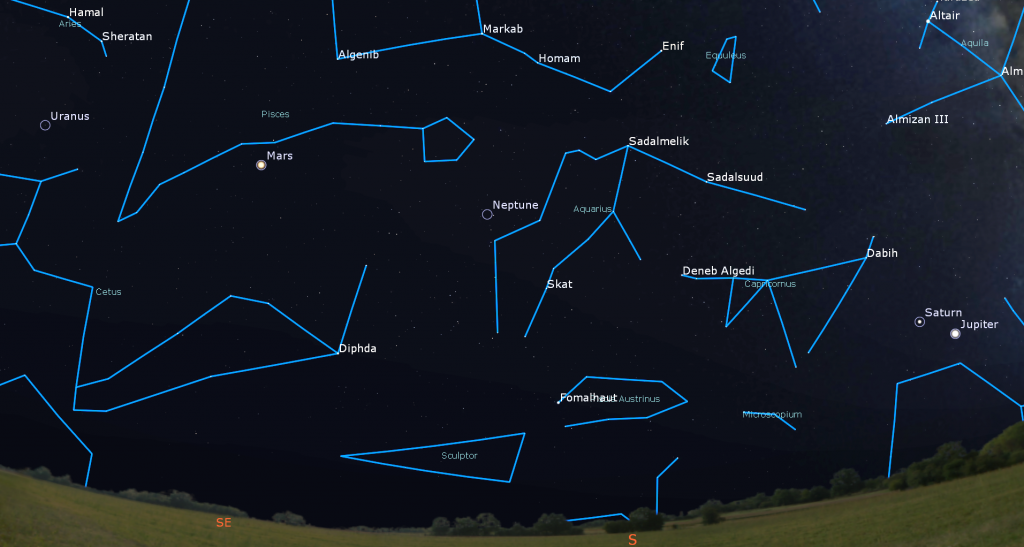
Our season of clear telescope views of those two planets is just about over. After 7 pm in your local time zone, they will be getting very low in the southwestern sky, and shining through a much thicker blanket of Earth’s atmosphere. You might even see them twinkle a little bit before they set! Thankfully, the earlier sunsets have allowed us to start viewing them earlier each night.
Good binoculars should show you the four large Jupiter moons that Galileo Galilei discovered in January, 1610. Named Io, Europa, Ganymede, and Callisto, they dance around the planet from night to night – although one or more can be hidden by Jupiter at any given time. If the air is steady, even a modest-sized telescope will show Jupiter’s brown bands and the famous Great Red Spot (or GRS, for short). Due to Jupiter’s 10-hour rotation period, the GRS will be visible every second or third night at your location on Earth. In the Eastern Time zone, the Great Red Spot will be crossing the planet’s disk after dusk on Thursday and Saturday, and crossing just before Jupiter sets on Monday.
From time to time, the round, black shadows cast onto Jupiter by its Galilean moons are visible in amateur telescopes as they cross (or transit) the planet’s disk for a few hours. On Monday, November 16 from 6:35 pm to 8:45 pm EST, Io’s small shadow will cross Jupiter – but only observers in the Central time zone will see the end of the crossing. Transit and GRS events will be visible anywhere on Earth where Jupiter is above the horizon during the time windows I’ve quoted (adjusted to your local time zone). Other places will see different transits.
Saturn is a spectacular sight. Any backyard telescope will show you Saturn’s rings. See if you can see the Cassini Division. It’s the narrow, dark gap that separates Saturn’s main inner ring from its outer one.
Your telescope should also reveal several of Saturn’s moons – especially its largest, brightest moon, Titan! Because Saturn’s axis of rotation is tipped about 27° from vertical (a bit more than Earth’s axis), we are seeing the top surface of its rings – and its moons can arrange themselves above, below, or to either side of the planet. The trick for seeing more moons is to watch continuously for a minute or two, and let the dimmer, closer-in moons appear in those moments when the air stabilizes. During evening this week, Titan will migrate counter-clockwise around Saturn, moving from the lower right of Saturn tonight (Sunday) to the upper left of the planet next Sunday. (Remember that your telescope might flip the view around.) Fun fact: There’s a Lake Ontario on Titan!
Back in June and July, when they were moving retrograde westward, Jupiter and Saturn passed close to a globular star cluster named Messier 75 (or M75). Now that the two planets have resumed normal eastward motion, they are going to pass that cluster again. This week, in binoculars or telescopes, look for a faint fuzzy patch located about two finger widths to the upper left (or 2.5 degrees to the celestial southeast) of Saturn. Try to see the globular cluster between about 6 and 7 pm local time, when it’s higher and the sky has darkened fully. And try to make your attempt early this the week, when the moon still won’t be shining in the sky after dusk.
Mars is still a great evening and late-night target! This week, the bright, reddish-tinted planet will already be shining in the lower part of the southeastern sky after dusk. Mars will climb to its highest point – and best viewing position, a bit more than half-way up the southern sky – at about 9:30 pm local time. Then it will set in the west before sunrise.
Viewed in a telescope this week, Mars will display the dark, wedge-shaped Syrtis Major region and the bright, adjacent Hellas and Aeria regions that flank it, and the dark Mare Cimmerium and Sinus Sabaeus regions. A good Mars mapping tool is here. Note that it flips the planet to match a typical telescope. You’ll need to know the Universal Time (UT) that corresponds to the local time when you are viewing the planet. In the Eastern Time Zone, 02:00 UT equals 9 pm EST.
Because Earth has been passing Mars on the “inside track” of the solar system, Mars has been moving retrograde, causing the planet to appear to travel westward compared to the narrow “V” of modest stars at the bottom of the constellation of Pisces (the Fishes). On Sunday, November 15, Mars will cease that westward motion and resume its regular easterly prograde motion. That means that Mars will be rapidly fading in brightness and size from this point forward.
Blue-green Uranus is among the stars of southern Aries (the Ram) – a fist’s diameter below and between Aries’ two brightest stars Hamal and Sheratan. For context, that region of the sky is two fist diameters to the left (or 22° to the celestial east) of Mars. At magnitude 5.7, Uranus is within reach of backyard telescopes, binoculars, and even sharp, unaided eyes – while the moon isn’t too bright. Try for Uranus after mid-evening, when it will be higher in the sky. I posted a detailed star chart for Uranus here.
Deep blue Neptune is located about 2.7 fist diameters to the right (celestial west) of Mars – among the stars of northeastern Aquarius (the Water-Bearer). Look for the dim, magnitude 7.86 planet sitting about two finger widths to the left (or 2 degrees to the celestial east) of the medium-bright star Phi Aquarii or φ Aqr. This week, dim and distant planet will already be in the lower southeastern sky after dusk. Then it will climb higher until just before 8 pm local time, when you’ll get your clearest view of it while it’s almost halfway up the southern sky. I posted a detailed sky chart for Neptune here.
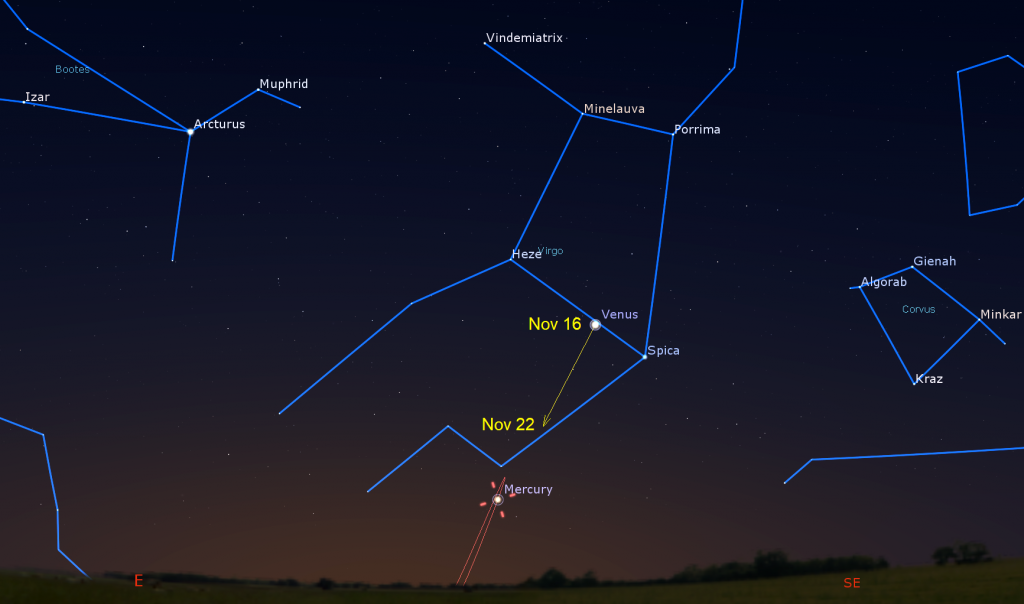
Venus has been gleaming in the eastern pre-dawn sky for some time now. It will rise at about 4:30 am local time this week, and then remain visible in the eastern sky until sunrise while it is carried higher by the rotation of the Earth. Viewed in a backyard telescope, Venus will show a slightly less than round shape. This week, the planet will be traveling down (or celestial eastward) through the stars of Virgo (the Maiden) – passing to the left of that constellation’s brightest star Spica during mid-week. Venus is shifting towards the sun – but the later sunrises at this time of year will allow it to shine in a dark, pre-dawn sky until early December!
For Northern Hemisphere observers, this week will continue to be good for viewing Mercury in the eastern pre-dawn sky; but it will be a poor apparition for those located near the Equator and farther south. Look for the swiftly-moving planet shining brightly very low in the east-southeastern sky, below and a bit to the left of Venus, between about 6 and 6:30 a.m. in your local time zone. Try to look earlier in this week, as Mercury is now descending sunward. In a telescope Mercury will have a similar shape to Venus. Be sure to put binoculars and telescopes away well before the sun rises!
Comet in Orion
This week, a comet named C/2020 M3 (Atlas) will be passing through the northern part of Orion (the Hunter) – so it will be observable after mid-evening! The comet’s designation indicates that it was the third comet discovered during the first half of August, 2020, using ATLAS, an automated asteroid impact early warning system developed by the University of Hawaii and funded by NASA.
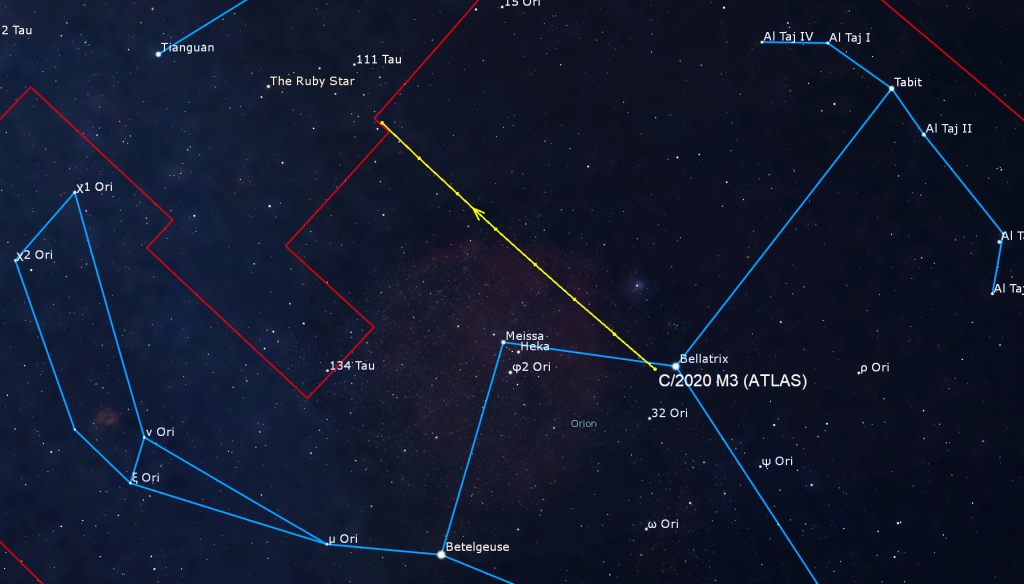
At the present time, the comet is shining at a modest magnitude 9 – putting it within reach of amateur telescopes while the moon is still a thin, early-setting crescent. Comet Atlas has already peaked in brightness, and will rapidly dim in the coming weeks as it leaves both the sun’s warmth and Earth observers behind.
Tonight (Sunday) the comet will be located just a finger’s width to the left (or 30 arc-minutes to the celestial northeast) of the bright star Bellatrix, Orion’s western shoulder star. On each subsequent evening the comet will rapidly travel to the upper left (or celestial north).
I viewed the comet about a week ago. You should expect the comet to appear as a faint fuzzy star, with a slightly greenish hue.
Deep Sky Delights for November
If you missed last week’s tour of the terrific deep sky objects to view during this mostly moonless week, I posted the write-up and sky charts for them here.
Public Astro-Themed Events
Every Monday evening, York University’s Allan I. Carswell Observatory runs an online star party – broadcasting views from four telescopes/cameras, answering viewer questions, and taking requests! Details are here. Their in-person Wednesday night viewing has been converted to online via the observatory Youtube channel, where they offer free online viewing through their rooftop telescopes, including their new 1-metre telescope! Details are here.
On Monday afternoon, November 16 at 1:30 pm EST, McMaster University’s Origins Institute will live stream a free presentation by Dr. Brad K Gibson, Professor and Director of the E.A. Milne Centre for Astrophysics at the University of Hull in the UK. His topic is Where are the Aliens?!?. Details and the Zoon registration link are here.
My free, family-friendly Insider’s Guide to the Galaxy webcasts with Jenna Hinds of RASC National will return on Tuesday, November 17 – when we’ll talk about meteor showers and meteorites. (Send us suggestions!) You can find more details, and the schedule of future sessions, here and here. Don’t forget to tune in to Jenna and John Reid’s final RASC Explore the Universe certificate livestream on Thursday, October 29 at 3:30 pm EDT.
Keep looking up, and enjoy the sky when you do. I love questions and requests. Send me some!